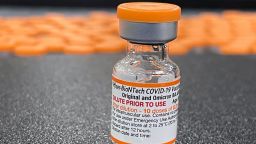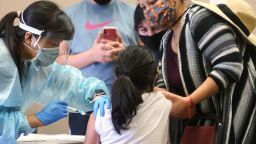Covid-19 vaccines will be part of recommended immunization schedules in 2023 for both children and adults, after a unanimous vote by the US Centers for Disease Control and Prevention’s independent Advisory Committee on Immunization Practices.
That doesn’t make the vaccines mandatory for anyone, a point that was emphasized in a discussion before Thursday’s vote. The board members addressed concerns from the public that adding Covid-19 vaccinations to the schedule would force schools to require the shots.
“We recognize that there is concern around this, but moving Covid-19 to the recommended immunization schedule does not impact what vaccines are required for school entrance, if any,” said Dr. Nirav Shah, a committee member and director of the Maine Center for Disease Control and Prevention.
“Indeed, there are vaccines that are on the schedule right now that are not required for school attendance in many jurisdictions, such as seasonal influenza. Local control matters, and we honor that. The decision around school entrance for vaccines rests where it did before, which is with the state level, the county level and at the municipal level, if it exists at all. They are the arbiters of what vaccines are required, if any, for school entry. This discussion does not change that.”
In fact, Covid-19 vaccines are explicitly banned from being included in school mandates in at least 20 states. Only California and the District of Columbia have announced that Covid-19 shots will be among mandated vaccinations for students, but those mandates were not implemented for this school year.
It’s been nearly a year since eligibility for the Covid-19 vaccine was expanded to include everyone in the US 5 and older, but coverage among children still lags behind that of adults. Even as these vaccines and the related mandates have become highly politicized over the course of the pandemic, experts say vaccine hesitancy among parents isn’t new.
Although the Covid-19 shot will not become mandatory for school, all 50 states do have laws requiring specific vaccines for students – most of which include shots for measles, mumps and rubella (MMR), diphtheria, tetanus and pertussis (DTaP) and varicella.
Uptake for these vaccines, mandated by schools long before Covid-19, fell during the pandemic.
In the 2020-21 school year, vaccination coverage for kindergarteners fell to less than 94% – dropping below the overall target of 95% that was set as an objective by the US Department of Health and Human Services in the Healthy People project for the first time in six years.
A CNN analysis of the latest CDC data suggests that students in states with stricter school vaccine requirements are more likely to have their shots.
All school immunization laws grant exemptions to children for specific medical reasons. But 44 states and Washington, DC, also grant religious exemptions, and 15 states allow philosophical or moral exemptions for children, according to the National Conference of State Legislatures.
According to the CNN analysis, states that were stricter with exemptions were much more likely to still meet the 95% coverage target. In the 2020-21 school year, an average of about 96% of kindergarten students had their MMR vaccine in states that allowed only medical exemptions, compared with 92% of students in states that also allowed philosophical or moral exemptions.
The full effect of the pandemic on children’s routinevaccination rates isn’t clear: It will be another few months before the CDC shares national data forcompliance rates for mandatory vaccinations in the 2021-22 school year, and schools are in the midst of outreach and programming to ensure that as many students as possible will continue through the 2022-23 school year up to date on their vaccines.
Vaccine hesitancy isn’t new
Correcting the drop in vaccination coverage in students will probably depend more on better access to care, information and outreach – and school vaccine mandates can help.
With many people who are hesitant, it’s “because of something they’ve heard or something they’ve read,” said Dr. Jesse Hackell, a pediatrician who co-authored a clinical report about countering vaccine hesitancy in 2016. “Most people [who are hesitant]have a very free-floating worry about vaccines. It’s not specific in most cases.”
A small share of parents – about 2% or 3% – are adamantly opposed to vaccines, and that rate has stayed mostly consistent over the years, said Hackell, who is also chair of the American Academy of Pediatrics Committee on Practice and Ambulatory Medicine.
Overall vaccination coverage fell among kindergarteners in the 2020-21 school year, but the share of students who had an exemption also declined from 2.5% to 2.1%, according to CDC data. The rate has changed by less than 1 percentage point over the past 10 years.
About 3% of kindergarteners in the US – about 120,000 students – were considered to be out of compliance with mandatory vaccines in the 2020-21 school year.
“Mandates may not do anything to those people who would pull their kids out of public school,” Hackell said. “But the vast majority of parents are not opposed. They’re hesitant, or they’re uncertain. And when there’s pressure to do it for another reason, such as getting your kid into school, they come around.”
Responsibility for enforcing vaccine mandates falls to the education system, and practices vary by state. Some students are ultimately turned away because they aren’t up to date, but most states offer provisional enrollment periods that allow kids to stay in school if they are in progress with at least one shot in a series or evidence of an upcoming appointment.
According to the CDC, “school officials may prefer to keep students in school where they have access to education, safe supervision, nutrition, and social services while working with parents or guardians to get children vaccinated.”
And many states do their best to help students stay up to date on their immunizations, with vaccination drives and direct followup with parents.
“I think that the drop in the past year or two is partly pandemic-related,” Hackell said. “What we’re seeing, I think, is a little bit of a disparity between kids who have a medical home and have a private [doctor] versus kids who get their immunizations from a public source” like a school clinic.
A model of high vaccination: Mississippi
Mississippi is an impressive example of finding ways to keep child vaccination rates high, Hackell says. Public schools are the only option for many in the state, where poverty rates are higher than anywhere else in the US.
Despite the large public need and additional resource struggles that the pandemic brought, 99% of kindergarteners in Mississippi met required vaccination coverage in the 2020-21 school year – better than any other state, according to the CDC.
“They’ve done a tremendous job at that,” Hackell said, and it demonstrates the power of mandates. Mississippi is strict with exemptions – one of just six states allowing medical reasons only – and just 0.1% of kindergarteners were exempt in the 2020-21 school year.
Hackell says he would be most concerned if he sees a sustained drop in vaccination rates for highly transmissible diseases, especially measles and polio. And he’s worried about pockets of low vaccination rates in certain communities.
Schools are public spaces with a level of control, and 95% vaccination coverage is a goal with intent.
“We know it’s never going to be 100% because there are some people who cannot medically be vaccinated. But if you have 95%, that means in any given school classroom of 30 kids, there might be one unvaccinated kid. And so if that child brings a case of something into the class, there’s nobody else to give it to,” he said. “It stops there with one case.”
And when it comes to adding Covid-19 vaccines to the CDC’s recommended immunization schedule, the focus is still on public health – not on adding another requirement.
Get CNN Health's weekly newsletter
Sign up here to get The Results Are In with Dr. Sanjay Gupta every Tuesday from the CNN Health team.
“I’ve had parents who come in my office, and I say, ‘What are you here for?’ And they say, ‘Well, we’re here for vaccines so that our kids can go to school.’ And I’ve said, ‘OK, I understand that, but really I’m not vaccinating so you can go to school, I’m vaccinating because I want to prevent serious disease and death in your kids,’ ” Dr. Matthew Daley, an ACIP member and senior investigator with the Institute for Health Research at Kaiser Permanente Colorado, said at Thursday’s advisory meeting.
“And the fact that there’s a school immunization requirement helps because it brought you into the office, but that’s not my goal. My goal is to prevent serious disease.”
CNN’s Carma Hassan contributed to this report.






